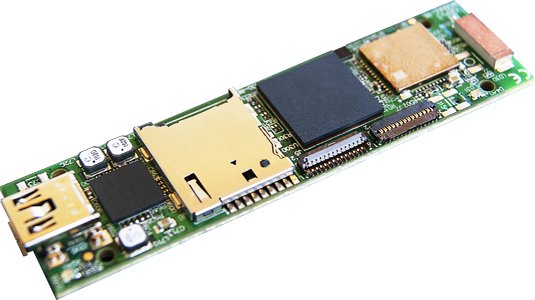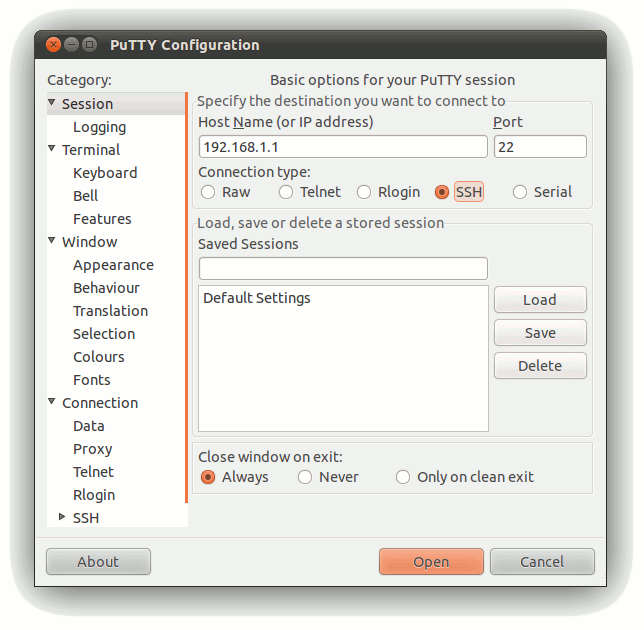Getting Started with IGEP0030 board
From IGEP - ISEE Wiki
IGEP0030
|
| Getting started with IGEP0030 |
| This page is a starting point for all products of the IGEP0030 family such IGEP COM MODULE. |
| Overview | ||
| 1) Connect USB OTG cable to a PC | ||
| 2) Log into IGEP0030 via USB Ethernet Gadget | ||
| 3) Log into IGEP0030 via Wifi | ||
This first chapter describes how to boot IGEP030 and also gives some basic instructions about how to connect some peripherals.
Setting up
In the first chapter of this tutorial we are going to use:
- an USB A type plug to mini B type plug
- a computer with Windows or Linux installed on it
Do NOT power up your board yet.
| Power up via USB OTG connector |
| Connect IGEP0030 to a computer via USB OTG |
The on-board HS USB OTG port is used as the default power input for IGEP0030 standalone operating mode.
First of all, connect IGEP0030 to your machine via the on-board USB OTG port with a USB cable (USB A type plug to mini B type plug).
Connect IGEP0030 to your machine. It will power up.
Connect to IGEP0030 via USB OTG connector
| Overview |
| 1) Install a SSH client such PuTTy
2) Connect via USB Ethernet Gadget/RNDIS driver, SSH: root@192.168.7.2 |
You can log into IGEP0030 via many interfaces with network connectivity, such wifi, usb-ethernet gadget.. and many others (when connected to an IGEP Expansion Board).
In this tutorial we are going to connect via USB Ethernet gadget. This feature allows you to have an IP connection over USB.
IGEP0030 uses this functionality to allow users to log via SSH.
You can use this feature to interact with the IGEP Processor operating system [host] by typing commands in a client machine (your PC, for example) to perform specific tasks in IGEP0030. You can communicate and open a debug session via many other interfaces such Serial port, Ethernet, Wifi, USB Ethernet Gadget, etc. (if available in an IGEP Expansion Board, for example).
Therefore, you will be able to access IGEP0030 from your client device (for example, a PC with Linux, Windows, etc.)
To allow that, IGEP0030 comes with an USB interface static IP: 192.168.7.2
Note: You will be able to change it later
Now you must run any serial console that allows SSH such PuTTy (Linux, Windows).
You can download it from its official page at: http://www.chiark.greenend.org.uk/~sgtatham/putty/download.html
Then, run the SSH client and start a SSH session to connect to the host (IGEP0030) from the client (your PC):
- Select the SSH at connection type.
- Next insert the IP address of the target. In this case, the IGEP0030 default IP (192.168.7.2).
- Ensure that the port is set to 22, the default for SSH communications.
- Finally, push the Open button to start the SSH session.
If everything goes right, you will be able to access to an IGEP0030 console from your PC via USB Ethernet gadget.
Connect to IGEP0030 via Wifi
| Overview |
| 1) Install a SSH client such PuTTy
2) Connect via wireless connection, ESSID: WLAN_IGEP, SSH: root@192.168.6.1 |
(Work in progress article. Coming soon!)
Once the board is powered up and running, we will get Ethernet connectivity over the same USB cable (USB Ethernet Gadget/RNDIS driver) or via wireless.
By default, the IGEP0030 usb interface will have the IP address 192.168.7.2, and the wireless interface comes with WLAN_IGEP as ESSID and 192.168.6.1 as IP address.
The next step is: What can I do with IGEP0030
This guide is divided in three different chapters:
- Getting started: A basic tutorial about how to connect and boot your IGEP0030
- What can I do?: An extensive article to setup the main peripherals of IGEP0030
- Start developing: Once you have successfully followed the previous tutorials, you are ready to start developing with IGEP Technology. Here you will find some basic tips tricks about how to start with it.
For further information about this board, there exist other sections where you can find specific and extended contents, in-depth description, valuables web links, etc.
If that is your case, visit the main page of IGEP0030 or check the categories at the IGEP Community Wiki.




